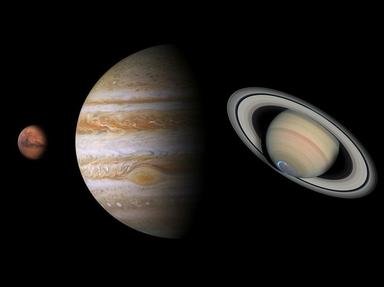Quiz Answer Key and Fun Facts
1. Your spaceship has finally arrived! Your first stop is the center of our Solar System, the Sun. There, you want to see a sun spot up close. What IS a sun spot, anyways?
2. You land on Mercury. Being such a small planet, Mercury is unable to have a thick atmosphere. Nonetheless, it has an atmosphere. Which of the following gases would be foreign in Mercury's atmosphere?
3. Venus sure is bright... On a clear night you can usually distinguish it from the stars. Hey, you know another bright thing in the sky? The full moon. I wonder which is brighter? Hmmm... You decide. (Remember, negative numbers are brighter)
4. I could ask why Mars is the called "The Red Planet," but I won't, too much of a cliche. Instead I'll ask about its moons. The two moons of Mars, Phobos and Deimos, are named after which characters in mythology?
5. Taking off from Mars and continuing to the farthest reaches of the Oort Cloud, where is the next sightseeing location?
6. Orbiting Jupiter for the first time, you pass over the Great Red Spot. It's a storm, so maybe it rains water? No, it isn't. Hey, speaking of spots and water, which of Earth's oceans is closest in size to the Red Spot?
7. Wow, Saturn's rings sure are beautiful! I wonder how they got there? What's a major theory on how Saturn got its rings?
8. Passing over Uranus, it appears like a huge mass of swirling blue. You may see it clearly, yet Uranus was not discovered without a telescope, in spite of being visible to the naked eye. Why was this?
9. Though more famous for its huge storms, Jupiter isn't the only planet with large storms. In fact, Neptune has three major storms in its atmosphere. What are their names?
10. Flying over Pluto brings back the memories of its controversial loss of planet status. However, the former planet's demotion sparked up a new word meaning 'minor planet, planetoid.' What is this word?
Source: Author
ellstrich
This quiz was reviewed by FunTrivia editor
crisw before going online.
Any errors found in FunTrivia content are routinely corrected through our feedback system.

